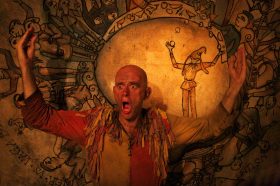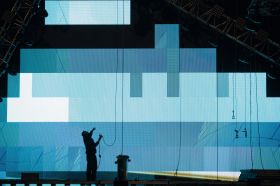Paul Capsis, Nathan O’Keefe, Alirio Zavarce in Windmill Theatre’s Pinocchio. Image by Brett Boardman.
Even though the audience may be most familiar with Collodi’s original The Adventures of Pinocchio or Disney’s 1940 animated film, Windmill Theatre’s Pinocchio stands solidly of its own merit. In adapting this traditional fairytale, the company delivers more than is expected of a children’s production, and proves that even the oldest story maintains its appeal to a contemporary audience.
At face value, this new adaptation is a thoroughly engaging, extroverted rock-musical. Each facet cooperates homogenously: the re-penned narrative by Rosemary Myers and Julianne O’Brien, Jethro Woodward’s array of catchy musical numbers and Chris More’s bursting animations. From the flying motorcycle to the revolving stage, the production’s impressive aesthetic (Jonathon Oxlade, designer) gains constant gasps and excited whisperings from the audience.
The characters of the story are larger than life and easily capture the imagination. Besides the titular Pinocchio (the fantastic Nathan O’Keefe), Cricket is probably the crowd’s favourite. Jonathon Oxlade is endearing and cute as the glowing, flying, voice of reason.
Beneath this whimsical façade is a wholesome story that examines the nuances of the human condition. Myers and O’Brien approach these underlying themes with an unexpected but intentional darkness, mimicking Collodi’s original text.
The devilish Stromboli (Paul Capsis) personifies everything that is wicked in the story. Capsis clearly enjoys himself as the villain, and possesses the role with both menace and an alluring flamboyance. While he draws more laughs than gasps, the character is undeniably fearsome. The theatre environment provides a metaphorical safety net, but Stromboli and the dark absurdist scenes may prove too overwhelming for the littlest children.
Of course, where there is evil, there is also good. The strongest through-line of the story is lonely Geppetto (Alirio Zavarce) and his deep yearning for a son. Love, friendship, corruption, honesty, and mortality: the father and his wooden puppet face a quagmire of psychological and emotional dilemmas.
This more involved narrative is what engages adult audience members. Geppetto and Pinocchio illustrate what it truly means to be a person, but contrary to preconceived expectations, the fairytale doesn’t provide a childish retreat for adults so much as a blatant exploration and subjugation of the woes of reality.
While Act I flew by in a cloud of colour and song, the function of Act II was not nearly as defined. It featured baffling audience participation, slightly dull musical numbers and empty narrative direction. With some revisions, Pinocchio could quite happily be a shorter, single act performance.
Despite this single criticism, Windmill Theatre clearly excels with Pinocchio. It is a special occasion when both young and old are enamoured of the same form of entertainment and exciting to see an Adelaide company so easily conquer the eastern stage.
Rating: 4 ½ out of 5 starsPinocchio
Windmill Theatre
State Theatre Company SA
Sydney Theatre Company
Director: Rosemary Myers
Writer: Julianne O’Brien
Designer: Jonathon Oxlade
Lighting Designer: Geoff Cobham
Composer & Musical Director: Jethro Woodward
Video designer: Chris More
Movement: Carol Wellman Kelly
Cast: Paul Capsis, Danielle Catanzariti, Jude Henshall, Luke Joslin, Nathan O’Keefe, Jonathon Oxlade, Alirio Zavarce, Paul White
Drama Theatre, Sydney Opera House
www.sydneyoperahouse.com
11 April – 4 May





